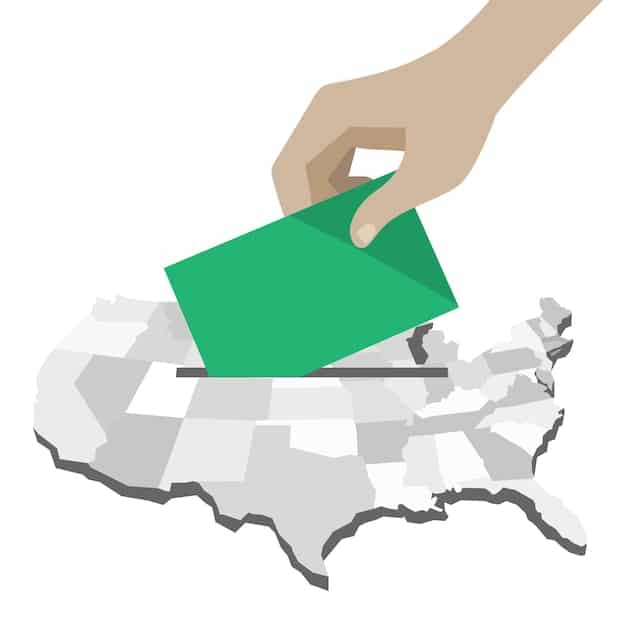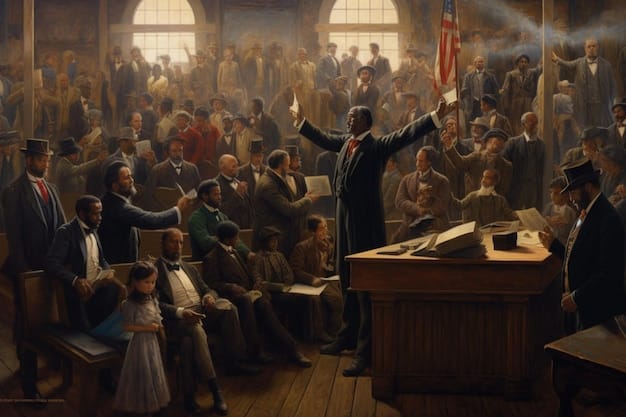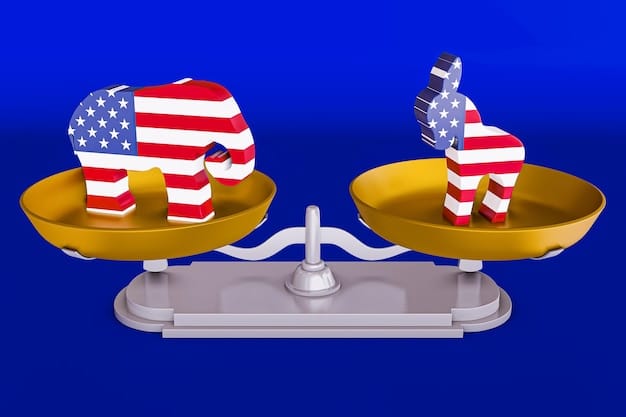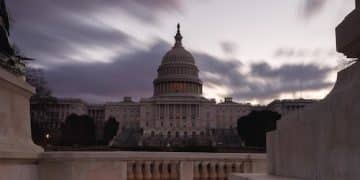The Future of the Electoral College: Abolition by 2030?

The Future of the Electoral College: Is it Still a Fair System, and What are the Chances of it Being Abolished by 2030? is a question debated fiercely, with arguments focusing on fairness, representation, and the potential for reform or even complete abolition of the current system in the coming years.
The debate around the **future of the Electoral College: Is it Still a Fair System, and What are the Chances of it Being Abolished by 2030?** rages on, fueled by concerns about its fairness and democratic representation.
Understanding the Electoral College: A Brief History
The Electoral College is a system established by the U.S. Constitution for electing the president and vice president. It’s not a direct popular vote, but rather a process where citizens vote for a slate of electors who then cast the actual votes for the president.
The founding fathers created it as a compromise between a popular vote election and a congressional election of the president. The intention was to balance the power between densely populated states and those with smaller populations.
The original intent
The Electoral College was designed to serve as a buffer between the population and the selection of a president. Some believed direct democracy could lead to tyranny of the majority.
Evolution over time
Over the years, the Electoral College has been impacted by changes in voting laws, political party development, and constitutional amendments. These modifications have altered the system’s effects on presidential elections.
- The establishment of political parties influenced how electors voted.
- Constitutional amendments, such as the 12th, changed procedures.
- Campaign strategies adapt to the Electoral College map.

Initially, electors had more discretion, but as political parties solidified and states adopted the unit rule (awarding all electoral votes to the popular vote winner), the system became more closely tied to popular vote outcomes.
Arguments for and against the Electoral College
The Electoral College is one of the most debated aspects of the U.S. political system. Supporters and critics cite a range of arguments, from protecting small states to undermining the popular vote.
Understanding the arguments is key to evaluating the potential for reform or abolition. Let’s explore some main points.
Protecting small states
A common argument in favor of the Electoral College is that it protects the interests of less populated states by giving them a disproportionately larger voice in presidential elections.
Undermining the popular vote
Critics argue that the Electoral College undermines the principle of one person, one vote, pointing to instances where the popular vote winner didn’t win the presidency.
- The 2000 election highlighted the potential disconnect.
- Small states receive disproportionate representation.
- Close elections demonstrate the system’s impact.
The debate over the Electoral College is often framed in terms of fairness and representation. While its supporters argue that it protects the interests of smaller states and prevents a “tyranny of the majority,” critics argue that it distorts the will of the people and undermines democratic principles.
Historical attempts to reform or abolish the Electoral College
Throughout U.S. history, there have been numerous attempts to reform or abolish the Electoral College. These efforts reflect ongoing concerns about its fairness and democratic legitimacy.
While none have been successful at the national level, they illustrate the continuing debate and the challenges of making changes to such a fundamental aspect of the political system.

Constitutional amendments
Several proposed constitutional amendments have aimed to abolish or modify the Electoral College. These proposals have encountered significant political hurdles.
National popular vote interstate compact
The National Popular Vote Interstate Compact is an agreement among states to award their electoral votes to the candidate who wins the national popular vote. It would only go into effect after enough states join to control a majority of the electoral votes.
Efforts to reform or abolish the Electoral College have faced an uphill battle due to constitutional requirements and partisan divisions. The complexity of the issue makes it difficult to build consensus.
Potential scenarios for the 2024 election
The Electoral College continues to shape presidential campaign strategies and election outcomes. Given the current political climate, several scenarios could play out in the 2024 election.
Understanding these scenarios and their potential consequences is vital for voters and political observers alike.
Swing state influence
A few key swing states often determine the outcome of presidential elections due to the Electoral College system. Candidates pour resources into these states.
Impact of third-party candidates
Third-party candidates can also influence the Electoral College by potentially siphoning off votes from the major party candidates in key states.
- Ross Perot in 1992 impacted Clinton and Bush.
- Ralph Nader in 2000 impacted Gore and Bush.
- The impact depends on specific state vote margins.
The 2024 election will likely be shaped by the nuances of the Electoral College, including the influence of swing states and the potential impact of third-party candidates. These factors make predicting the outcome challenging.
The role of the Supreme Court
The Supreme Court has played a role in shaping the Electoral College through its rulings on election-related cases. These decisions can have significant implications for the system’s operation.
It’s crucial to understand the Court’s impact and the legal principles that guide its decisions.
Bush vs. Gore
The Supreme Court case Bush v. Gore decided the outcome of the 2000 presidential election, highlighting the Court’s power in election disputes.
State control over electors
The Supreme Court has affirmed the right of states to control how their electors vote, further defining the relationship between the popular vote and the electoral vote.
The Supreme Court’s interpretation of election laws and the Constitution can have a direct impact on the functioning of the Electoral College, influencing everything from recounts to the role of electors.
Looking ahead: predicting the future of the Electoral College
Predicting the future of the Electoral College involves many variables, including shifts in public opinion, political dynamics, and potential legal challenges. Is it still a fair system, and what are the chances of it being abolished by 2030?
Examining these factors can offer insight into the possible trajectories of this controversial system.
Public opinion trends
Public opinion on the Electoral College has shifted over time, with an increasing number of Americans favoring a national popular vote. This sentiment could influence future reform efforts.
Political feasibility of abolition
Abolishing the Electoral College would require a constitutional amendment, which is a high hurdle in the current political climate. Party divisions make consensus even harder.
- Requires a two-thirds vote in Congress.
- Then ratification by three-fourths of the states.
- This is a difficult threshold to achieve.
The future of the Electoral College is uncertain, but shifts in public opinion and the changing political landscape could create opportunities for reform or even abolition. However, overcoming the constitutional barriers remains a significant challenge.
| Key Point | Brief Description |
|---|---|
| 🗳️ Electoral College Purpose | System created by the U.S. Constitution for electing the president and vice president. |
| ⚖️ Arguments For/Against | Protects small states vs. undermines the popular vote. |
| 📜 Reform Attempts | Constitutional amendments and national popular vote interstate compact. |
| 🏛️ Supreme Court’s Role | Shaped the Electoral College through rulings on election-related cases, like Bush vs. Gore. |
Frequently Asked Questions
▼
The Electoral College is a constitutional mechanism used to elect the President and Vice President of the United States. Instead of directly voting for a candidate, citizens vote for a slate of electors, who then vote for the presidential candidates.
▼
The Electoral College was created as a compromise between electing the president by popular vote and electing the president by a vote in Congress. It aimed to balance the influence of densely populated states with that of less populated states.
▼
Abolishing the Electoral College would require a constitutional amendment, which needs to be proposed by a two-thirds vote of both houses of Congress and ratified by three-fourths of the states. This makes abolition a difficult and lengthy process.
▼
Yes, there have been instances where the candidate who won the popular vote did not win the presidency due to the Electoral College. Examples include the 2000 election, where George W. Bush won over Al Gore, and the 2016 election, where Donald Trump won over Hillary Clinton.
▼
The National Popular Vote Interstate Compact is an agreement among states to award their electoral votes to the candidate who wins the national popular vote. It would only take effect when enough states join to control a majority of the electoral votes (270).
Conclusion
The **future of the Electoral College** remains a subject of intense debate. While some argue for its preservation to protect the interests of smaller states, others advocate for its abolition in favor of a national popular vote. The likelihood of abolishing the Electoral College by 2030 appears slim, given the constitutional hurdles and political divisions. However, ongoing discussions and public sentiment could pave the way for potential reforms in the future.





